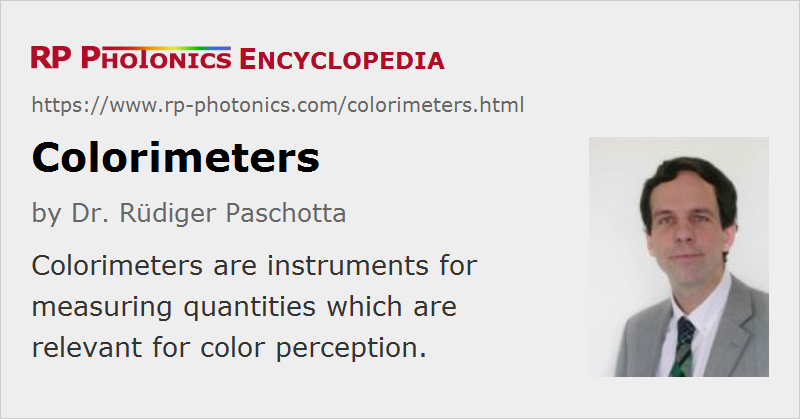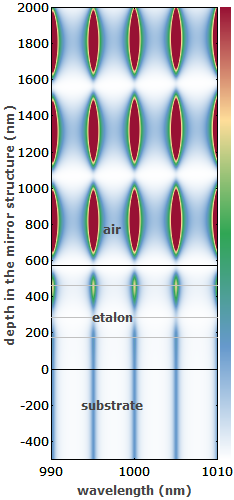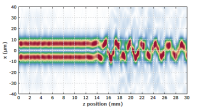Colorimeters
Definition: instruments for measuring quantities which are relevant for color perception
German: Kolorimeter, Farbmessgeräte
Category: light detection and characterization
How to cite the article; suggest additional literature
Author: Dr. Rüdiger Paschotta
In a strict sense, colorimeters are instruments for measuring physical quantities which are relevant for color perception. Typically, such devices deliver tristimulus values, e.g. of CIE RGB, CIE XYZ or LMS type. These are coordinates in some chosen color space.
The term colorimeter is also sometimes used in a wider sense for instruments in applications where the color impression is not the aspect of actual interest, but one only uses wavelength-dependent absorption, for example, for retrieving information on other aspects such as the concentration of some light-absorbing species in a solution. That somewhat inaccurate use of the term is common in analytical chemistry, for example.
Colorimeters of different types can be applied either to light (e.g. from some light sources used for illumination) or to objects which interact with light, such as dyes and paints. Some typical types of colorimeters and their typical applications are explained in the following.
Colorimeters for the Characterization of Light Sources
Frequently, one needs to objectively characterize the color or the color balance of light – for example, of white light used for illumination. In other cases, e.g. in LED testing for signal lamps, one may check the consistency of a colored light output.
In any case, what is generally of interest is not the full optical spectrum of the light, as can be measured with some kind of optical spectrometer (more specifically, a spectroradiometer). Instead, in colorimetry one is only interested in the resulting color perception. That information is frequently captured in the form of tristimulus values. In earlier times, color measurements were often based on the visual comparison of objects with color reference objects, but such methods are no more common.
Different kinds of tristimulus values may be appropriate, depending on the application. For example, one may want to obtain RGB values, so that the obtained color can be easily reproduced with an RGB color display (possibly after applying a mathematical correction – a color transform – if the two RGB color spaces are not identical). In other cases, one may require LMS tristimulus values, indicating the responses of the cone receptor cells in the human eye.
If a tristimulus colorimeter works based on an RGB color space, certain spectral absorption features may not produce the same color results as for a human eye. Such observer metamerism color errors can be minimized by optimizing the spectral response curves; one may try, for example, to fulfill the Luther condition (after Robert Luther), obtaining a true colorimetric instrument.
Tristimulus Colorimeters
The simplest method for measuring tristimulus values (used in tristimulus colorimeters, sometimes also called filter photometers) is to use the combination of a suitable optical filter and a photodiode (often a silicon photodiode). For example, a suitable red, green or blue filter may modify the spectral response of a photodetector (i.e., the wavelength-dependent responsivity) such one obtains RGB (red, green and blue) color values in the used RGB color space. Simple devices of that type can be relatively cheap, lightweight, compact and robust. A compact instrument may contain the actual measurement device, a display and everything else; in other cases, there is a compact external measurement head, which is typically connected to the rest of the instrument with a cable.
A modified operation principle is based on a single photodetector and a rotating filter wheel; measurements with different filters are then not done simultaneously, but subsequently. That principle is particularly suitable for imaging colorimeters (see below).
Note that an RGB color space, for example, cannot be used to accurately represent arbitrary colors: there are colors outside the RGB gamut, which would mathematically have a negative value for at least one of the three coordinates – which, however, can of course never occur in such an instrument, because a measured intensity cannot be negative. (For any monochromatic light, for example, that problem occurs.) That limitation, however, it not always practically relevant, e.g. if the further processing of colors anyway involves such limitations: it does not help to accurately record colors which can anyway not be accurately printed or displayed.
It is possible to substantially expand the color space by using one or more additional photodetectors with other filters, where one then combines the four or five measurement values to calculate the delivered tristimulus values.
Colorimeters with a Spectrometer
For avoiding the limitation of the accessible color space, one may use a more sophisticated measurement method with an optical spectrometer, which has to span the full visible spectral range. From the obtained optical spectra, one can calculate all sorts of tristimulus values simply by spectrally integrating the product of the spectral intensity with appropriate filter functions. The problem with observer metamerism is also eliminated that way. Further, such instruments are usually computer-controlled, which allows them to offer various useful additional features (see below). However, the obvious disadvantages of that approach are the substantially higher cost, the larger size and weight (often making such devices non-portable) and their typically lower robustness.
In some imaging colorimeters (see below), one actually combines both operation principles: the actual measurements are performed based on the optical filter principle of the simple tristimulus colorimeter, but there is also a single-channel spectrometer for calibrating the color data. Such a combination of methods may also be used where ultimate measurement speed is required.
An advanced colorimeter may be able to output tristimulus values of different kinds. For example, it may output both CIE RGB values and CIE XYZ values. This can the most accurate for an instrument containing a spectrometer, as explained above. However, in a simpler device one may apply color transformations to the original tristimulus values.
Colorimeters for Characterizing Colored Objects
Often, one needs to characterize colors of (not light-emitting) objects such as paints. This can be done by illuminating such objects in a well-controlled way and analyzing light which is transmitted, reflected or scattered at the object. That light analysis can be done with the same methods as explained above – for example, with a simple tristimulus color detector or in case of more advanced devices with a spectrometer. For controlled illumination, there are light sources acting as CIE standard illuminants such as D65 with a correlated color temperature of about 6500 K.
A suitable light source can be integrated into a colorimeter and mounted such that the directions of the incident and analyzed light against the analyzed surface are the same for all measurements. Typically, one would avoid a geometry where specular reflections from the object reach the detector, because those may exhibit a completely different reflectance spectrum. Some devices can perform measurements for different illumination or observation directions (illumination or viewing angles against the surface normal). In other cases, one uses diffuse illumination, which can be achieved with an integrating sphere. Likewise, it is possible to diffuse the reflected light with an integrating sphere in order to analyze light scattered in all directions. Obviously, the used measurement condition should be clearly specified to make the color data meaningful.
Colorimeters and Color Management
Colorimeters can be applied within a color management system. For example, one may process color images, produced with color-calibrated photo cameras, such that printing data are obtained with well defined color data. The printed results can then be checked with a colorimeter. Similarly, accurate color reproduction on a computer screen may be checked by making colorimeter measurements on the screen and possibly readjusting its settings accordingly. If all elements of such a color management system are well controlled, a natural color appearance of the results may be guaranteed.
Color management is mostly applied for professional print and photographic productions, but usually not with consumer devices. For example, consumer cameras are not only not precisely calibrated for certain color space, but also often apply automatic color corrections based on heuristic algorithms; in that process, much of the actual color information is lost already. That can of course not be recovered later on e.g. by calibrating a computer monitor with a colorimeter. Similarly, all-purpose color laser printers and ink jet printers usually do not accurately adhere to a certain color space. Also, color details may gradually change over time.
Additional Features
Instrument Calibration
For accurate colorimetry, a colorimeter may occasionally need to be recalibrated. Therefore, high-end devices often offer corresponding calibration features. A simple solution is that they come with certain reflectance standards, which are optimized for keeping a well-defined color appearance over longer times. Besides, a manufacturer may offer calibration services.
Reference Colors
Some colorimeters can store some number of recorded color values, which can subsequently be used as color references. They can then display not only the color values of a sample, but also the “distance” to a reference color.
Imaging Colorimeters
There are imaging colorimeters, which provide not only color information for one spot or for a homogeneous area, but produce spatially resolved 2D color data. Such an instrument may contain some focal plane array (e.g. a CCD or CMOS image sensor) in combination with a rotating filter wheel; one subsequently records images of the same scene with different parts of the filter wheel. In contrast to a simple spot colorimeter, such devices can be used for rapidly checking the homogeneity of color over some area – for example in the production of flat panel displays. Combined with suitable software, which may rapidly recognize objects on the images, imaging colorimeters can be very useful for example in industrial quality monitoring.
Extended Color Data
Various other types of potentially quite useful functions are offered particularly by computerized instruments. For example, they may provide the metamerism index.
Digital Interfaces
High-end colorimeters and even some lower-priced devices have a digital interface (e.g. of USB type). That allows one to control measurements from an external computer, store and compare data there, etc. For many applications, such as quality control in industrial manufacturing, the productivity can be enormously enhanced with such instruments.
Features Beyond Color Measurements
Some colorimeters offer additional features, which go beyond the purpose of color measurements. Some examples:
- The total intensity of illumination may be displayed, as for a simple luxmeter or photometer.
- High-end devices are often based on a spectrometer or spectrophotometer, and may then also deliver full optical spectra or reflection spectra in addition to pure color data.
- There are devices which can also measure the intensity of blue and ultraviolet light, for example for purposes of light hazard monitoring.
Colorimeters in Analytical Chemistry
In analytical chemistry and related areas, one uses some kinds of colorimeters for measuring the absorbance versus optical wavelength, mostly for calculating concentrations of certain light-absorbing species in solutions. As mentioned above, the term colorimetry is not really appropriate in those cases, because the measurement of colors is neither the final goal nor part of intermediate results. The aspect of color perception does not really play a role for such measurements. A more appropriate term for such an instrument would therefore be spectrophotometer. See the article on that topic for more details. Typically, a spectrophotometer provides many more than the three color channels of a colorimeter.
Suppliers
The RP Photonics Buyer's Guide contains 6 suppliers for colorimeters.
Questions and Comments from Users
Here you can submit questions and comments. As far as they get accepted by the author, they will appear above this paragraph together with the author’s answer. The author will decide on acceptance based on certain criteria. Essentially, the issue must be of sufficiently broad interest.
Please do not enter personal data here; we would otherwise delete it soon. (See also our privacy declaration.) If you wish to receive personal feedback or consultancy from the author, please contact him e.g. via e-mail.
By submitting the information, you give your consent to the potential publication of your inputs on our website according to our rules. (If you later retract your consent, we will delete those inputs.) As your inputs are first reviewed by the author, they may be published with some delay.
See also: colorimetry, color temperature, color rendering index, photometers
and other articles in the category light detection and characterization
 |








If you like this page, please share the link with your friends and colleagues, e.g. via social media:
These sharing buttons are implemented in a privacy-friendly way!